Psychologists suggest that true humility is not about making oneself smaller to please others, but being able to share praise and refuse misplaced blame. It’s developing a ‘right-sized’ combination of self-awareness, empathy, and openness to diverse perspectives. Support children’s learning about this sometimes elusive virtue with these activities, designed to help them understand what humility is, how it feels, and why it matters.
Who am I? Knowing one’s strengths and weaknesses is part of practicing humility. Encourage children to draw a simple self-portrait on a large sheet of newsprint. In the upper left quadrant, ask them to use their favorite color crayon or marker to write things they are good at. Then encourage them to use the same color to list other people who are good at those things in the upper right. In the lower left, invite them to use another color to write some things they aren’t very good at. In the final corner, invite them to use the same color to identify people they could ask to help them with things they don’t do well.
What is it? To cultivate intellectual humility (openness to diverse perspectives), invite children to play a game where you hold up a simple object and ask them to list all the different things that object could be. For example, a plastic cup could be a drinking glass, a means to rinse hair in the bathtub, a measuring cup for sugar, etc. Encourage children to see how many different possibilities they can name before moving to a new object.
I was wrong. Admitting weaknesses and mistakes can be hard. Invite children to role play situations where they make a mistake and then admit it. Model this activity yourself first with this scenario: You accidentally knock a lego structure off a table and it breaks. At first, you try to claim it was the fault of the person who left it there, but then you decide to take responsibility and offer to help rebuild it. Encourage children to act out both defensive and humble responses.
That’s not me! Resisting when other people try to make you feel small is part of being appropriately humble. Guide children in this meditation. Say: Close your eyes and take a deep breath (pause) and let it out. (pause) Imagine you are helping make a salad. You know you are pretty good at tearing lettuce and chopping veggies. (pause) A neighbor comes over and says, “You’re making that salad all wrong! Here’s let me take over.” (pause) How do you feel when you hear those words? (pause) What do you want to say to help your neighbor see that you are good at salad-making? (pause) Take a deep breath in (pause) and out (pause), then open your eyes. Invite kids to share their feelings and responses.
Move over. Humility requires making space for others to shine too. Invite children to think about body postures and gestures that communicate that others are welcome to participate and contribute. For example, an outstretched arm pulled toward your body says, “Come help” or jumping up and down and clapping says, “That was great!”.Try out all the suggested movements together.
The Big Cheese. John Jory’s picture book, The Big Cheese, is a punny story about a wheel of cheddar so full of himself he can’t possibly imagine anyone else being as good as him. Read the story together and invite children to share what they think about the competition between Big and Wedge. Ask: Why do you think Big acts the way he does? When have you felt like Big? What do you think about Big’s change of heart near the end of the story?

Comments